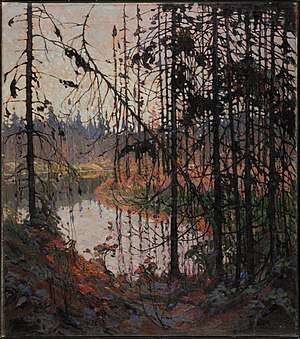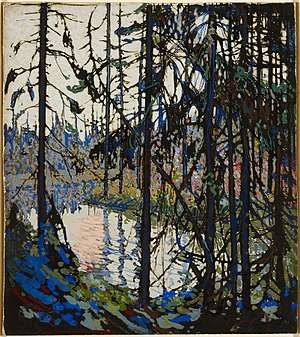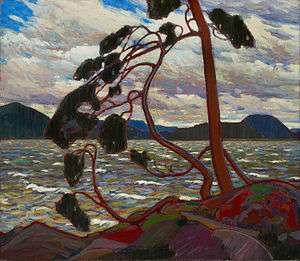Northern River (painting)
| Northern River | |
|---|---|
 | |
| Artist | Tom Thomson |
| Year | 1914–15 |
| Medium | Oil on canvas |
| Dimensions | 115.1 cm × 102 cm (455⁄16 in × 403⁄16 in) |
| Location | National Gallery of Canada, Ottawa |
| Accession | 1055 |
Northern River is a 1914–15 oil painting by the 20th-century Canadian painter Tom Thomson.
The work was painted as Thomson was entering the most prolific period of his art career and is considered one of his most notable works. The painting was purchased by the National Gallery of Canada in Ottawa in 1915 and has remained in the collection ever since.
Background
Thomson first visited Algonquin Park in May 1912,[1] venturing through the area on a canoe trip with his Grip colleague Ben Jackson.[2] Thomson's transition from commercial art towards his original style of painting began to be apparent around this time.[2][3] His early works, such as Northern Lake (1912–13) and Evening (1913), were not outstanding technically, yet they did illustrate an above average ability regarding composition and colour handling.[4]
Northern River and the winter of 1914–15 stand as a point of transition in Thomson's art. In 1914 he made himself a sketch box to hold 8½ × 10½ inch (21.6 × 26.7 cm) panels,[5] allowing him greater opportunity for sketching.[6] A. Y. Jackson in particular taught him about the subtleties of composition, colour and technique in general,[6] allowing the sketches that followed show a beginning desire to experiment with colour and texture rather than continue with the precision and subdued nature of his earlier works.[7]
Description
In a letter to James MacCallum, Thomson referred to Northern River as his "swamp picture."[8][9][10][note 1] Though Thomson was typically critical of his own work, he described the painting as being "not half bad" to a nephew.[12] David Milne, a Canadian artist and critic, praised the painting, writing in a letter,
Just plain impossible, but he has done it, it stirs you. Any painter who has ever worked on this overlying pattern motive will realize at once that this is tackling a complication beyond reason. A great point in Thomson's favour this, and his lack of perfection. I am wary of craftsmanship. It is nothing in itself, neither emotion nor creation. [...] I rather think it would have been wiser to have taken your ten most prominent Canadians and sunk them in Canoe Lake—and saved Tom Thomson.[9][13]
In an article for Canadian Magazine, MacCallumm would write about the uniqueness of the painting amongst Thomson's entire catalogue. In particular, while Thomson would normally depict trees as amalgamated masses, in this painting he gives them each an individual form:
Drawing was to [Thomson] the expression of form, and form might be expressed by any method, so long as the form is true. One would have expected that with his intimate knowledge of trees he would have loved to paint all their traceries. In the “Northern River” alone did he lavish detail on his trees and here only because it helped the pattern. In one in whom the sense of design, of decoration was so developed that is the more striking, for in his sketches and in his larger pictures he always treated trees as masses. In his painting of them he gives form structure and colour by dragging paint in bold strokes over an underlying tone. Like many other painters he felt the limitations of paint, the impossibility of expressing on a flat surface the solidity and thickness of a tree, and in some canvasses almost modeled them in paint, while in others he got the same effect by expressing them by deep grooves in the paint.[14]
The painting recalls elements of A. Y. Jackson's 1914 canvas, A Frozen Lake,[15] which Thomson likely saw in November 1914 before Jackson took it in December to be exhibited.[16] Both paintings share a motif of trees and thin, sinuous branches obscuring the view to a body of water.[15]
Given Thomson's love of poetry,[17] the title of the work may be a reference to the William Wilfred Campbell poem, A Northern River. Campbell was a Canadian poet who lived in Owen Sound, nearby to Thomson's hometown of Leith.[12]
Sketch to studio painting
| Study for "Northern River" | |
|---|---|
 | |
| Artist | Tom Thomson |
| Year | Winter 1914–15 |
| Medium | Graphite, brush and ink and gouache on illustration board |
| Dimensions | 30.0 cm × 26.7 cm (1113⁄16 in × 10½ in) |
| Location | Art Gallery of Ontario, Toronto |
| Accession | 82/176 |
It is not known where the original study was made. Though it is typically assumed to have been completed in Algonquin Park, Thomson's friend Winifred Trainor claimed that it was set outside the Park.[12] Curator Charles Hill has instead suggested that the sketch was "[p]robably painted in his Toronto studio, it is most likely a memory—an amalgam of experiences rather than a specific site."[15]
The initial sketch of the scene illustrates Thomson's adept ability to transform his small sketches into powerful studio paintings.[18] This is apparent with other sketch-painting pairings, such as Opulent October, Spring Ice, The Jack Pine and The West Wind, amongst many other examples.[9] Thomson's first gouache study of the work was brightly coloured partly because gouache reflects more light than oil on canvas does. To make the eventual studio painting livelier, he included reds, oranges and yellows within the foreground, though still maintaining the original gouache blends in the sky.[9][15] The dominant colour of the painting is black, an oddity within Thomson's corpus.[10][15] Curator and scholar Joan Murray has written that the final canvas closely follows the original study, but with key differences. For one, the canvas is devoid of the accidental brushstrokes present in the sketch. Foreground space was also added to better convey depth and the trees are simpler and more defined, with less foliage present.[12]
Art Nouveau
In Thomson's time as a commercial artist, he became familiar with the then contemporary decorative style of Art Nouveau.[19][20] Art historian David P. Silcox has described Northern River as utilizing the same sinuous forms that are to be found in the art style.[21] Of particular note are the "S-curves" of the trees which have their origins in Thomson's work as a draughtsman.[22] He would continue to utilize this motif in other later works, such as Decorative Landscape, Birches (1915–16) and The West Wind (1916–17).[23][24] Fellow artist A. Y. Jackson would affirm the Group of Seven's tendency towards using Art Nouveau styles within their work, writing that, "We (the Group of Seven and Tom Thomson) treated our subjects with the freedom of designers. We tried to emphasize colour, line and pattern."[25][26]
 Advertising or calendar drawing, Fall-winter 1912. Location unknown
Advertising or calendar drawing, Fall-winter 1912. Location unknown Decorative Landscape, Birches, Winter 1915–16. National Gallery of Canada, Ottawa
Decorative Landscape, Birches, Winter 1915–16. National Gallery of Canada, Ottawa Early Snow, Winter 1916–17. Winnipeg Art Gallery, Winnipeg
Early Snow, Winter 1916–17. Winnipeg Art Gallery, Winnipeg
Provenance and exhibition
The National Gallery of Canada purchased the painting from Thomson in 1915 for $500 (equivalent to CAD$11,000 in 2017),[27][28] essentially a years wage for a painter like himself.[9] Since then, it has appeared in over 30 exhibitions, including shows at Musée & du Jeu de Paume in Paris; Los Angeles; London; and Mexico.[29]
References
Footnotes
Citations
- ↑
- Hunter (2002), p. 25
- Klages (2016), p. 21
- Silcox (2006), p. 20
- Stacey (2002), p. 57
- 1 2 Silcox (2015), p. 10.
- ↑ Silcox (2006), p. 23.
- ↑ Silcox (2015), p. 11.
- ↑ Davies (c. 1930).
- 1 2 Hill (2002), p. 123.
- ↑ Hill (2002), pp. 127, 133.
- 1 2 Thomson (1915).
- 1 2 3 4 5 Silcox (2015), p. 26.
- 1 2 Murray (2004), p. 110.
- ↑ Murray (2002), p. 300.
- 1 2 3 4 Murray (1999), p. 46.
- ↑ Milne (1932).
- ↑ MacCallum (1918), pp. 379–80.
- 1 2 3 4 5 Hill (2002), p. 130.
- ↑ Hill (2002), p. 130 n. 107.
- ↑ Murray (1999), pp. viii, 12.
- ↑ Silcox & Town (2017), pp. 181–85.
- ↑ Silcox & Town (2017), pp. 94, 210.
- ↑ Reid (2002), pp. 65–83.
- ↑ Silcox (2015), p. 47, 71.
- ↑ Stacey (2002), p. 60.
- ↑ Stacey (2002), p. 59-60.
- ↑ Silcox (2015), p. 68, 71.
- ↑ McKay (2011), p. 185.
- ↑ Silcox (2015), p. 71.
- ↑ Silcox (2006), p. 209.
- ↑ Silcox (2015), p. 13, 65.
- ↑ "Northern River, Winter 1914–15 (1914–1915.11)". tomthomsoncatalogue.org. Tom Thomson Catalgoue.
Sources
- Davies, Blodwen. "Tom Thomson's Sketchbox" (c. 1930). Blodwen Davies collection, Series: 11, ID: MG30-D38. Ottawa: Library and Archives Canada.
- Hill, Charles (2002). "Tom Thomson, Painter". In Reid, Dennis. Tom Thomson. Toronto/Ottawa: Art Gallery of Ontario/National Gallery of Canada. pp. 111–43.
- Hunter, Andrew (2002). "Mapping Tom". In Reid, Dennis. Tom Thomson. Toronto/Ottawa: Art Gallery of Ontario/National Gallery of Canada. pp. 19–46.
- Klages, Gregory (2016). The Many Deaths of Tom Thomson: Separating Fact from Fiction. Toronto: Dundurn. ISBN 978-1-45973-196-7.
- MacCallum, James (31 March 1918). "Tom Thomson: Painter of the North". The Canadian Magazine. Vol. 50 no. 5. pp. 375–83.
- McKay, Marylin J. (2011). Picturing the Land: Narrating Territories in Canadian Landscape Art, 1500–1950. Montreal: McGill-Queen's University Press.
- Milne, David. "David Milne to Harry McCurry" (1 April 1932) [Letter]. Milne Papers. Ottawa: National Gallery of Canada Archives.
- Murray, Joan (1999). Tom Thomson: Trees. Toronto: McArthur & Company.
- ——— (2002). "Tom Thomson's Letters". In Reid, Dennis. Tom Thomson. Toronto/Ottawa: Art Gallery of Ontario/National Gallery of Canada. pp. 297–306.
- ——— (2004). Water: Lawren Harris and the Group of Seven. Toronto: McArthur & Company.
- Reid, Dennis (2002). "Tom Thomson and the Arts and Crafts Movement in Toronto". In Reid, Dennis. Tom Thomson. Toronto/Ottawa: Art Gallery of Ontario/National Gallery of Canada. pp. 65–83.
- Silcox, David P. (2006). The Group of Seven and Tom Thomson. Richmond Hill: Firefly Books. ISBN 978-1-55407-154-8.
- ——— (2015). Tom Thomson: Life and Work. Toronto: Art Canada Institute. ISBN 978-1-4871-0075-9.
- ———; Town, Harold (2017). The Silence and the Storm (Revised, Expanded ed.). Toronto: McClelland and Stewart. ISBN 978-1443442343.
- Stacey, Robert (2002). "Tom Thomson as Applied Artist". In Reid, Dennis; Hill, Charles C. Tom Thomson. Toronto/Ottawa: Art Gallery of Ontario/National Gallery of Canada. pp. 47–63.
- Thomson, Tom. "Tom Thomson to James MacCallum" (April 22, 1915) [Letter]. Dr. James M. MacCallum Papers, Series: Tom Thomson correspondence, Box: 5. Ottawa: National Gallery of Canada Archives.
Further reading
- Booth, David (1995). Images of Nature: Canadian Poets and The Group of Seven. Toronto: Kids Can Press. pp. 6–7.
- Davis, Ann (1998). "Thomson, Thomas John (Tom)". Dictionary of Canadian Biography. 14. Toronto: University of Toronto Press. p. 998.
- Foss, Brian; Paikowsky, Sandra; Whitelaw, Anne (2010). The Visual Arts in Canada: The Twentieth Century. Oxford University Press. p. 42. ISBN 9780195421255.
- Hannon, Gerald (September 2002). "Sunday in the Park With Tom". Canadian Art. 19 (3): 79–82.
- King, Ross (2010). Defiant Spirits: The Modernist Revolution of the Group of Seven. D & M Publishers. pp. 163–64, 166, 167, 190, 216, 403. ISBN 9781553658078.
- Murray, Joan (1994). Northern Lights: Masterpieces of Tom Thomson and the Group of Seven. Toronto: Key Porter Books Limited. pp. 55–56.
- ——— (1999). Tom Thomson: Trees. Toronto: McArthur & Company. pp. 46–47.
- ——— (2004). Water: Lawren Harris and the Group of Seven. Toronto: McArthur & Company. pp. 110–11.
- ——— (2011). A Treasury of Tom Thomson. Douglas & McIntyre. pp. 34–35. ISBN 9781553658863.
- Reid, Dennis (2002). Tom Thomson. Vancouver: Douglas & McIntyre. pp. 60, 130–32, 134, 193, 313–14. ISBN 978-1553654933.
- Silcox, David P.; Town, Harold (1977). The Silence and the Storm. Toronto: McClelland and Stewart. pp. 28, 58, 95.
- ——— (1996). Painting Place: The Life and Work of David B. Milne. Toronto: University of Toronto Press. p. 220.
- ——— (2002). Tom Thomson: An Introduction to His Life and Art. Richmond Hill: Firefly books. p. 58. ISBN 978-1552976821.
- ——— (2006). The Group of Seven and Tom Thomson. Richmond Hill: Firefly Books. pp. 52, 209. ISBN 978-1-55407-154-8.
- ——— (2015). Tom Thomson: Life and Work. Toronto: Art Canada Institute. pp. 25–26. ISBN 978-1-4871-0075-9.
- ———; Town, Harold (2017). The Silence and the Storm (Revised, Expanded ed.). Toronto: McClelland and Stewart. pp. 14, 47, 102, 181. ISBN 978-1443442343.
- Wistow, David; McKinley, Kelly (1999). Meet the Group of Seven. Toronto: Kids Can Press. p. 17.
External links
- Campbell, William Wilfred. "A Northern River". www.canadianpoetry.ca.
- Murray, Joan. "Northern River". tomthomsoncatalogue.org. Tom Thomson Catalogue Raisonné.
- ———. "Sketch for "Northern River"". tomthomsoncatalogue.org. Tom Thomson Catalogue Raisonné.
- "Northern River". www.gallery.ca. National Gallery of Canada.